What is an L-Square: Easy Guide to This Key Sewing Tool
Ever seen an L-shaped ruler and wondered what it’s for? This helpful tool is often called an L-square, but you might also hear it named a “tailor’s square” or an “L-rule for sewing.” It’s one of the key sewing tools for anyone who loves to create with fabric.
This guide will tell you all about the L-square. We’ll look at what it is, its different parts and features, and how it’s used for sewing and making patterns. If you’re new to sewing, a DIY crafter, or a fashion student, don’t worry! This guide is made to be easy to follow.
1. What is an L-square (tailor’s ruler) exactly?
1.1. What it means
- An L-square is a special kind of ruler that is shaped like the letter “L.” This L-shaped, right-angle design is its most noticeable feature. It’s a type of tailor’s square or right-angle tailor’s ruler. You can spot it easily because of this shape.
- Its main job is to help you draw perfect 90-degree corners (also called right angles) and straight lines. This helps create accurate 90-degree angles. Think of the corner of a square piece of paper – an L-square helps you make that perfectly.
1.2. Why the “L” shape is great
- The two arms of the ruler meet to form this perfect corner. It’s a simple design that does a very important job.
- This “L” shape is super important for “squaring” patterns and fabric. “Squaring” just means making sure your corners are exact 90-degree angles. For example, tailors use an L-square for squaring to ensure clothes fit well.
1.3. Who uses it?
Many people who work with fabric use L-squares. These include:
- Tailors
- Dressmakers
- Pattern designers
It’s a key piece of pattern drafting equipment and part of essential tailor’s supplies.
But it’s not just for professionals! Anyone who wants their sewing projects or crafts to look neat, accurate, and professional will find an L-square helpful. Pattern makers utilize L-squares for measurements to ensure their designs are precise.
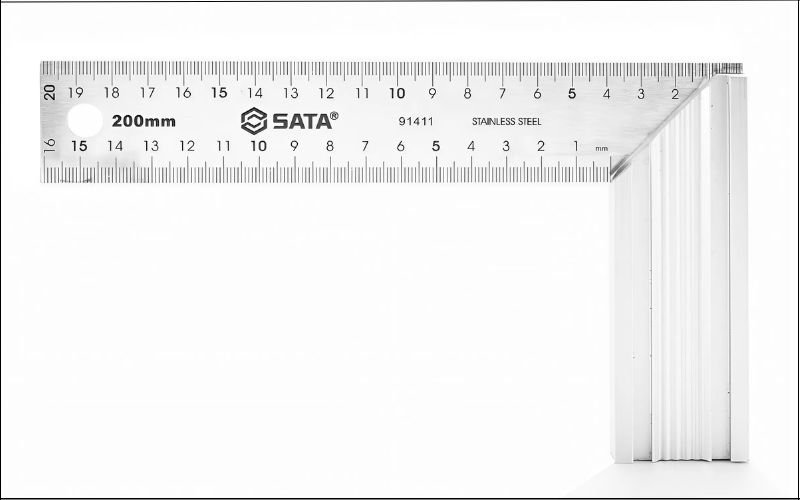
2. Look closer: parts and features of your L-square
Even though an L-square looks simple, it has some clever features that make it very useful.
2.1. The two arms
- The Long Arm is usually the longer part of the “L”. It has various measurement lines and numbers. You’ll often find special markings on the Long Arm, such as scales for it, like scales for Halves, Thirds, Sixths, Twelfths. These are for more advanced pattern work, but good to know they are there for measuring.
- The Short Arm is the shorter part. It also has measurement lines. The scales on the L-Square Arm (Short) – Markings might be different from the Long Arm. For example, you might find scales for Halves, Quarters, Eighths, Sixteenths here.
2.2. The very important 90-degree corner
- This is the point where the long arm and the short arm meet.
- This corner is made to be exactly a 90-degree angle. One of its unique characteristics is its ability to provide precise 90-degree angles essential for squaring patterns. This precision is what helps you get truly square corners in your work.
2.3. Understanding the lines and scales (numbers)
This is where the L-square really shows its usefulness with measurements, thanks to its various lines and scales.
Regular measurements:
Most L-squares will have standard measurement scales (e.g., inches, centimeters, fractional). You’ll typically see inches, often divided into 1/8th or 1/16th sections, and sometimes centimeters. It typically features graduated markings (e.g., inches, 1/2 scale, 1/6 scale).
Special fraction scales:
- What they are: These are special number lines for fractional scales (halves, sixths, eighths), and also often for thirds (1/3), quarters (1/4), and more. One of the L-square’s unique characteristics: features built-in fractional scales (e.g., halves, thirds, sixths) simplifying measurement division.
- Why they are good: These scales make it easy to divide measurements without doing math in your head or using a calculator. This is very helpful for scaling patterns (like making a pattern half-size) or quickly adding seam allowances. For instance, using an L-square to make half scale patterns becomes much simpler. So, understanding L-square ruler measurements and scales is key to getting the most out of it.
- Where they are: The placement can vary, but often the L-Square Arm (Long) – Markings include Halves, Thirds, Sixths, Twelfths. The L-Square Arm (Short) – Markings might have Halves, Quarters, Eighths, Sixteenths. Some brands, like those that produce rulers of the Fairgate L-Square Rulers type, often have specific, well-known layouts for these scales.
2.4. What it’s made of
The material of an L-square (e.g., metal, plastic) can affect how well it works and how long it lasts.
Metal (like Aluminum):
A common material: metal (Aluminum) is often used. This is good because it’s strong, keeps its shape well, and the markings are usually clear and durable. One of its unique characteristics: durable construction, often metal, for long-lasting accuracy.
Plastic:
Plastic L-squares are lighter. However, they can sometimes bend, which might affect accuracy. They are generally less strong and durable than metal ones.
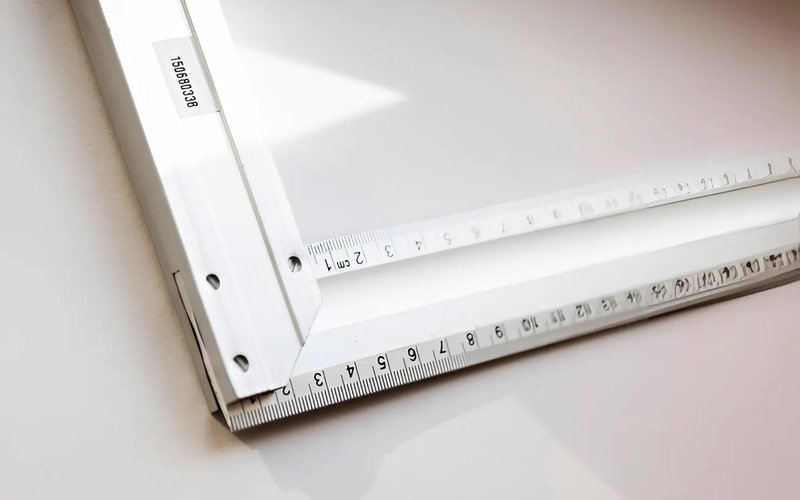
2.5. Common sizes
- A very popular size for an L-square has a 24-inch long arm and a 14-inch short arm. A very popular size, often considered standard, is 24 inches on the long arm and 14 inches on the short arm (14″ x 24″).
- Other sizes do exist. You might find smaller ones for tiny projects or even rare attributes: extra-large or miniature sizes for specific tasks, but the standard size is usually very versatile.
3. Why you need an L-square: its benefits
An L-square is more than just a ruler; it offers many great benefits for your sewing and crafting.
3.1. Makes things exact
The biggest benefit is accuracy. Perfect square corners and straight lines lead to better-fitting garments and a more professional look. It’s essential for creating accurate angles in garment patterns.
3.2. Saves time
The special fraction scales are big time-savers. You can divide measurements or adjust patterns quickly without needing a calculator or doing complicated math.
3.3. Useful for many things
It’s very versatile! Here are some uses:
- Drawing new patterns (Pattern drafting).
- Changing existing patterns (pattern alteration).
- Checking if fabric pieces are accurate before sewing.
- Many steps in garment construction.
- It’s a key tool for application: Flat Pattern Drafting.
3.4. A basic tool for good design
The L-square is a fundamental tool if you’re serious about making clothes, designing patterns, or doing detailed crafts. It’s one of the essential tools for tailors and designers. Remember, the L-square is a pattern drafting tool that professionals count on for good design.
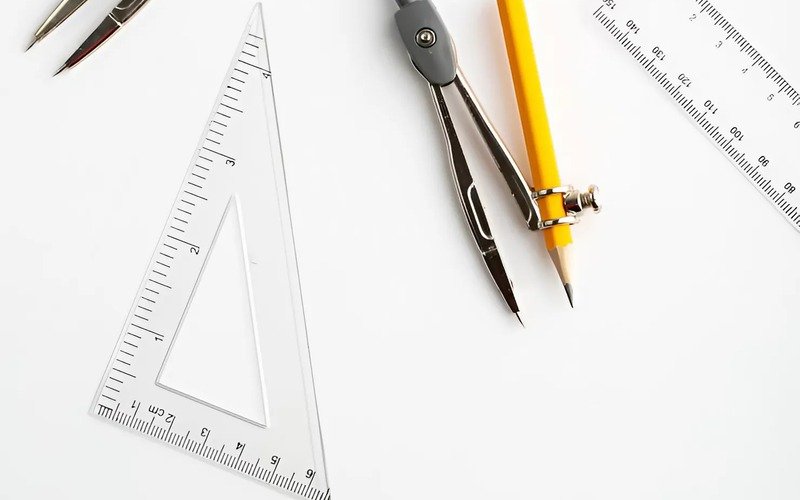
4. How to use your L-square: simple steps for basic jobs
Using an L-square is easy once you know a few basic steps. The pictures and diagrams here will help you see how it’s done.
4.1. Drawing super straight lines
- Place one arm of the L-square along an edge that’s already straight, or along a mark you’ve made.
- Hold the L-square firmly so it doesn’t slip.
- Draw your line along the edge of the other arm of the L-square.
4.2. Making perfect 90-degree corners (squaring lines)
This is one of the main uses, and it’s key for how to use a tailor’s L-square for drafting patterns.
- First, draw one straight line.
- Now, place one arm of the L-square exactly along this first line.
- Draw a new line along the edge of the other arm. This new line will be at a perfect 90-degree angle to your first line. The L-square tool for sewing and dressmaking is perfect for this task.
4.3. Checking if something is square
- Take the inside corner of your L-square.
- Place this inside corner right into the corner you want to check (this could be on a paper pattern piece or a corner you’ve sewn on fabric).
- If both sides of the item you’re checking line up perfectly with the arms of the L-square, then your corner is a true 90-degree square!
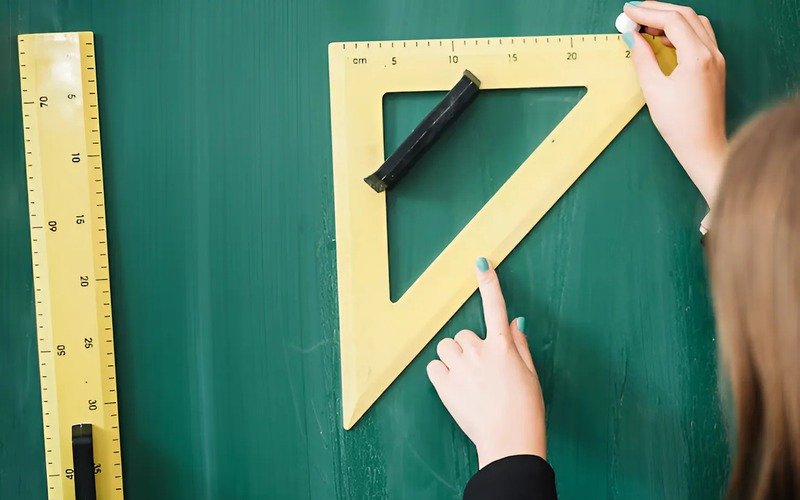
4.4. Using fraction scales to change patterns
This is where those special scales come in handy, especially when you ask, “What is an L-square ruler used for in pattern making?” in this context.
Example 1: Adding space for sewing (seam allowance)
Let’s say you need to add a 1/2 inch seam allowance. You can look for the “halves” scale on your L-square and use the “1” mark (which represents 1/2 inch on that scale), or simply find the regular 1/2 inch mark on the standard inch scale. Place the L-square along your pattern line and mark out your 1/2 inch.
Example 2: Making a pattern half size. (This shows using an L-square to make half scale patterns.)
Imagine a pattern piece is 10 inches long in full size. To make it half size, find the “halves” scale (often marked as 1/2 scale) on your L-square. On this 1/2 scale, find the number “10”. The actual distance from the zero point to this “10” mark on the 1/2 scale will be 5 real inches. You simply use the numbers on the 1/2 scale as if they were full inches to draw your half-size pattern.
How to read these scales:
It’s simple: if you are using the 1/2 scale, every number you see on that scale represents half of that value in actual inches. For example, the mark “6” on the 1/2 scale is actually 3 inches from the zero point. The mark “12” on the 1/2 scale is actually 6 inches from the zero point.
4.5. Drawing basic pattern shapes (intro)
- The L-square is excellent for drawing basic rectangles and squares. These shapes are often the starting foundations for pattern pieces like skirts or bodice blocks.
- It’s also used to draw the initial straight guidelines for things like necklines and armholes, before you use a French curve to draw the actual curve. This is part of basic pattern drafting techniques.
4.6. Checking fabric lines (grainlines)
- On most woven fabrics, there’s a finished edge called the “selvedge.” This edge runs along the lengthwise grain of the fabric.
- To find the cross-grain, line up one arm of your L-square perfectly with the selvedge edge of your fabric.
- The other arm of the L-square will now point exactly along the cross-grain, which is 90 degrees to the selvedge.
- Knowing your grainlines helps you cut your fabric correctly. This is very important for how your finished garment will hang and fit.
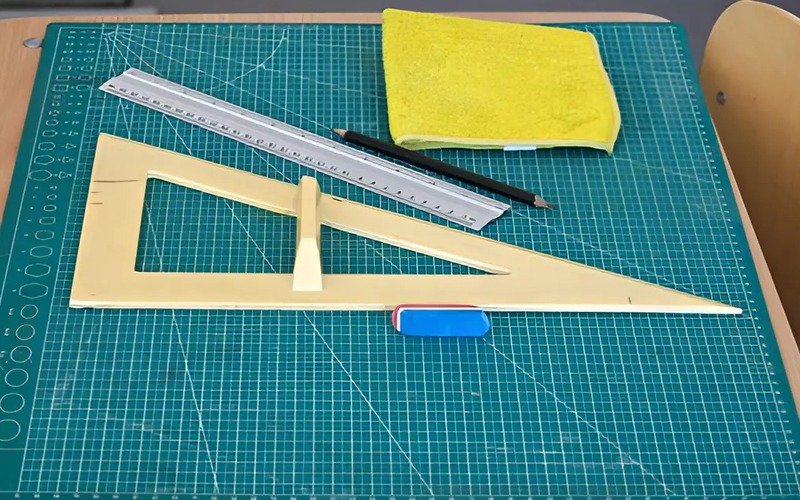
5. Picking a good L-square for you
When you’re ready to buy an L-square, think about these things:
5.1. Material
- Metal (usually aluminum): This is generally the best choice. It’s strong, durable, and the edges stay true for accurate lines. As mentioned, the root attributes: material (e.g., metal, plastic) matter, and metal is often preferred for L-squares.
- Plastic: These are lighter and often cheaper. However, they can warp or break more easily, and their accuracy might not be as reliable over a long time.
5.2. Markings (numbers and lines)
- Make sure the numbers and lines (markings) are clear and easy to read.
- It should definitely have inches (if that’s what you use). The feature: graduated markings (e.g., inches, 1/2 scale, 1/6 scale), especially the fractional scales (like halves, quarters, eighths), are a huge help. Check that it has the fractional scales you think you’ll need.
5.3. Size
- L-Square Ruler – Standard Size – 14″ x 24″ (24 inches on the long arm, 14 inches on the short arm) is very common and works well for most adult garments and general sewing projects.
- If you mainly make small items, like children’s clothes or small crafts, a smaller L-square might be easier to handle.
- While there are rare attributes: extra-large or miniature sizes for specific tasks for very big or very small projects, the standard size is usually the most versatile.
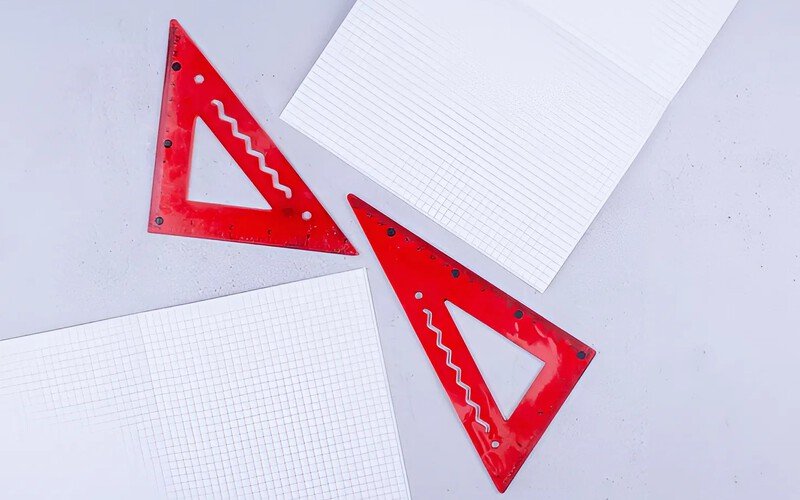
6. L-square vs. other sewing rulers
There are many sewing tools and rulers available for sewing and pattern making.
- You’ll find simple straight rulers for general measuring.
- French curves have curved edges and are used for drawing smooth curves for armholes, necklines, and similar areas.
- Hip curves have gentler curves, perfect for shaping hip lines on skirts and pants.
So, what makes the L-square special compared to these other rulers?
- Built-in 90-degree angle: This is its defining feature. No other common sewing ruler has this fixed, perfect right angle ready for instant squaring.
- Helpful drafting scales: Those special fractional scales for dividing measurements (like halves, quarters, eighths) are usually only found on L-squares or other specialized pattern drafting rulers. They make sizing and adjustments much easier.
While other rulers are essential for drawing curves or general measuring, the L-square is the champion for creating perfect right angles and making measurement division easy.
7. Quick tips: take care of your L-square
To keep your L-square working well for a long time, follow these simple tips:
7.1. Keep it flat or hang it up
The best way to store a metal L-square is to hang it flat (many have a hole for this) or lay it completely flat on a surface. This helps prevent it from bending or warping, which keeps that 90-degree corner accurate.
7.2. Keep it clean
Wipe off any chalk marks, pencil lines, or dust from your L-square regularly. A clean surface makes the markings easier to read.
7.3. Try not to drop it
Be especially careful with metal L-squares. If you drop it, you could dent an edge or, worse, knock that important 90-degree corner out of alignment. This would mean it loses its main advantage of accuracy.
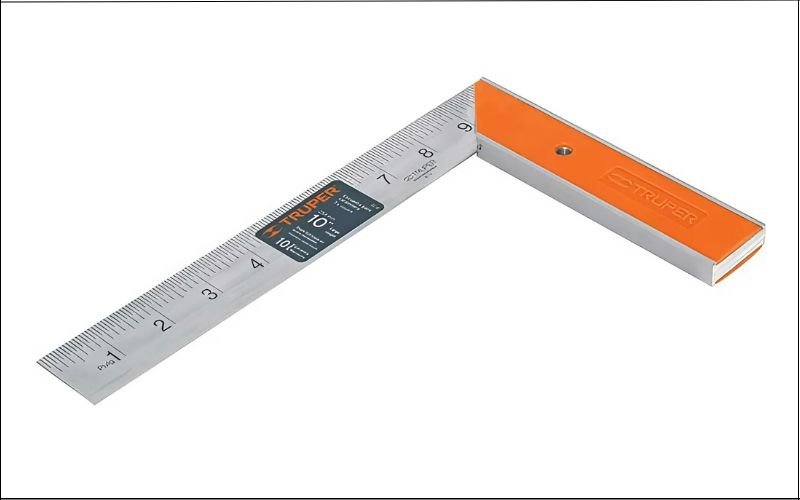
8. Common questions (FAQs)
Here are some common questions people ask about L-squares:
8.1. Why are there so many different numbers and lines on an L-square?
An L-square has lines for regular measurements (like inches or centimeters) AND special fractional scales (like halves, quarters, eighths, etc.). These special lines make it much easier to divide measurements when you’re making or altering patterns, which helps to understand the markings and scales on an L-square.
8.2. Can I just use a normal ruler instead of an L-square?
A normal ruler is good for drawing straight lines. However, it doesn’t have that built-in, perfect 90-degree angle for easily making square corners. Also, most normal rulers don’t have the special fractional drafting scales that L-squares have for quick measurement division. The L-square is specifically designed for right angles and scaled measurements.
8.3. What’s the main job of an L-square?
The main job of an L-square is to help you draw and check perfect 90-degree angles and straight lines. This ensures your patterns are accurate, which leads to better-fitting and more professional-looking sewn items. This answers questions like “Define what an L-square is” and helps you “Learn how an L-square is used in sewing or pattern making.”
8.4. Is an L-square only for professional tailors?
No, not at all! While professionals certainly rely on them, L-squares are also fantastic for home sewers, hobbyists, DIY crafters, and fashion students. Anyone who wants more accuracy and neatness in their fabric projects will find an L-square very useful.
8.5. Where can I get an L-square?
You can usually find L-squares at sewing supply stores, craft stores, fabric shops, and art supply stores. Many online retailers also sell them.
Read more:
Let’s review: the L-square, also known as a tailor’s square or tailor’s ruler, is a special tool prized for its accuracy and precision. Its primary use is pattern drafting, making it one of the essential measuring tools in sewing
It’s valuable for everyone, from beginners just starting out to professional designers and tailors. The L-square’s ability to create perfect right angles and simplify measurements makes it a fantastic helper for all sorts of fabric projects.
The more you use your L-square, the more comfortable and skilled you’ll become with it. So, don’t be afraid to practice! Now that you know all about L-squares, are you ready to add this essential tool to your sewing kit? Explore your local craft or fabric store!






















